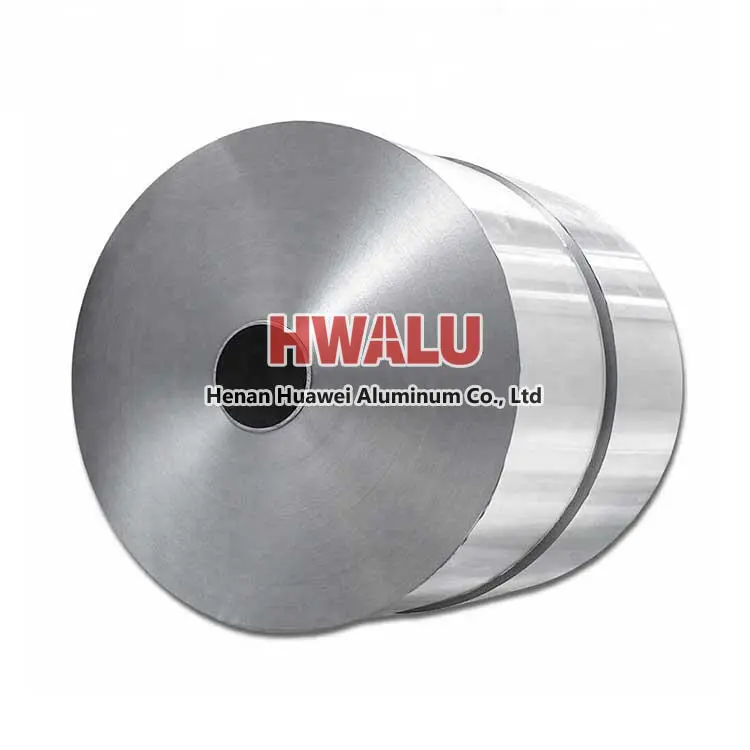Single zero aluminum foil refers to aluminum foil with a thickness between 0.01mm ( 10 micron ) and 0.1mm ( 100 micron ). 0.01mm ( 10 micron ), 0.011mm ( 11 micron ), 0.012mm ( 12 micron ), 0.13mm ( 13 micron ), 0.14mm ( 14 micron ), 0.15mm ( 15 micron ), 0.16mm ( 16 micron ), 0.17mm ( 17 micron ), 0.18mm ( 18 micron ), 0.19mm ( 19 micron ) 0.02mm ( 20 micron ), 0.021mm ( 21 micron ), 0.022mm ( 22 micron ...
Introduction of 8079 alloy aluminum foil What is aluminum foil grade 8079? 8079 alloy aluminum foil usually used to produce kinds of aluminum alloy foil, which offers the best properties for many applications with H14, H18 and other tempers and thicknesses between 10 and 200 microns. The tensile strength and elongation of alloy 8079 are higher than other alloys, so it is not flexible and moisture resistant. ...
What is Aluminum Foil? Aluminum Foil Roll Aluminum foil roll for aluminum foil refers to a raw material used to produce aluminum foil, usually an aluminum foil roll with a certain width and length. Aluminum foil is a very thin aluminum material, its thickness is usually between 0.005 mm and 0.2 mm, and it has good electrical and thermal conductivity and corrosion resistance. Aluminum foil jumbo rolling Aluminu ...
Welcome to Huawei Aluminum, your premier destination for Household Foil Jumbo Rolls 8011 Alloy. As a leading factory and wholesaler, we take pride in delivering top-quality products to meet your household, food packaging, and industrial aluminum foil needs. About Huawei Aluminum At Huawei Aluminum, we have a commitment to excellence, and we have been serving our clients with dedication for many years. Our e ...
In addition to cigarette packaging, the applications of aluminum foil in the packaging industry mainly include: aluminum-plastic composite bags, pharmaceutical aluminum foil blister packaging and chocolate packaging. Some high-end beers are also wrapped in aluminum foil on the bottle mouth. Medical packaging Medicinal blister packaging includes medicinal aluminum foil, PVC plastic rigid sheet, heat-sealing pain ...
leading manufacturer and wholesaler of high-quality 1200 Aluminum Foil At Huawei Aluminum, we take pride in being a leading manufacturer and wholesaler of high-quality 1200 Aluminum Foil. With a rich history of delivering top-notch products to our global clientele, we are committed to excellence in both quality and service. Explore our comprehensive range of 1200 Aluminum Foil, where precision meets purity. ...
Now the aluminum foil we see in the market is no longer made of tin, because it is more expensive and less durable than aluminum. The original tin foil (also known as tin foil) is really made of tin. Tin foil is softer than aluminum foil. It will smell tinted to wrap food. At the same time, tin foil cannot be heated due to its low melting point, or the heating temperature is high-such as 160 It begins to becom ...
Coiling defects mainly refer to loose, layer channeling, tower shape, warping and so on. Aluminum foil roll during the winding process. Because the tension of aluminum foil is limited, enough tension is the condition to form a certain tension gradient. Therefore, the winding quality ultimately depends on good shape, reasonable process parameters and suitable precision sleeve. It is ideal to obtain tight coils ...
Anodized Aluminum Foil Overview Anodized aluminum foil is aluminum foil that has been anodized. Anodizing is an electrochemical process in which aluminum foil is immersed in an electrolyte solution and an electric current is applied. This causes oxygen ions to bond with the aluminum surface, forming a layer of aluminum oxide. It can increase the thickness of the natural oxide layer on the aluminum surface. This ...
Color-coated aluminum foil is an aluminum foil material with a coated surface. By applying one or more layers of organic coatings or special functional coatings on the surface of the aluminum foil, the color-coated aluminum foil has the characteristics of diverse colors, beautiful and durable, and diverse functions. Color-coated aluminum foil has many product characteristics, beautiful, weather-resistant, durabl ...
Do you know "aluminum foil"? Definition of aluminum foil material What is aluminum foil material? Aluminum foil material is a material that is directly rolled into thin sheets using metal aluminum (aluminum plate with a certain thickness). Aluminum foil has the characteristics of soft texture, good ductility, and silver-white luster. It is widely used in many fields. The following is a detailed introduction t ...
A watch, two, feel, three, folding, four, twist, 5, knife scraping, 6, fire method, to help you identify the plastic composite packaging is made of aluminum foil or aluminum film material. Two, watch: the brightness of the packaging aluminum layer is not as bright as the aluminum plated film, that is, the packaging made of aluminum foil is not as bright as the packaging made of the aluminum plated film. Alumin ...










